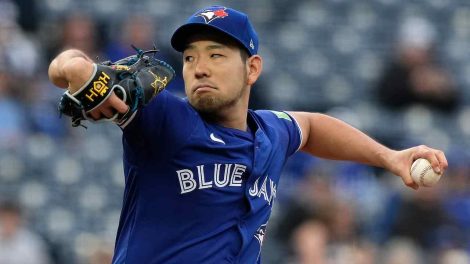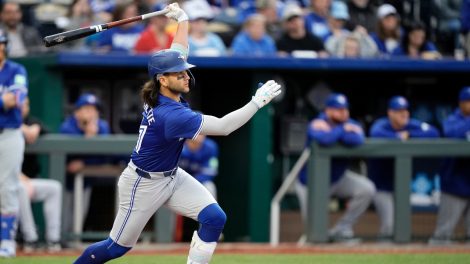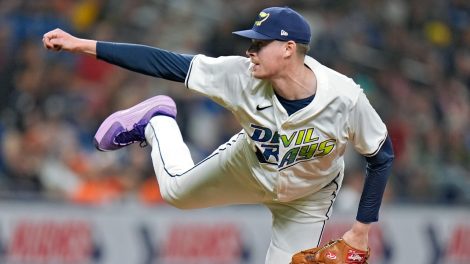DUNEDIN, Fla. – Nothing in baseball is as consistently contentious as the strike zone. Hitters think it’s too big, pitchers think it’s too small and everyone has an opinion, often an unflattering one, on the way how umpires interpret it.
For those reasons an adjustment of the zone upwards is the most significant and delicate idea in a series of rule changes Major League Baseball is proposing with the aim of increasing action on the field and cutting the amount of dead time in games.
The idea, commissioner Rob Manfred explained during a spring training media day, is to move the bottom of the zone up a couple of inches as a way to generate more balls in play. The change did not come on a whim, but rather from "data on how effective the batters handle that low strike, and that is something that has driven our thinking," he said.
"The theory is the pitch below the knee is being called a strike more frequently, that that particular pitch is hard to hit and that forcing pitchers up in the zone would produce more action," he said. "It is sort of restoring the natural order, getting back to where we were."
For now the proposals – which also include time-saving measures such as automatic intentional walks, limiting the amount of time managers have to decide on replay challenges and starting extra innings at the rookie-ball level with a runner on second – remain at the discussion level with the players association and are far from settled. Union resistance could squash them all.
[snippet]
A handful of Toronto Blue Jays players surveyed on the matter Friday were lukewarm to the ideas, particularly the tweak to the strike zone, a change they’d need to acclimate to over a month’s worth of Grapefruit League action.
"It’s tough," said catcher Jarrod Saltalamacchia, who’d benefit from the change at the plate but suffer from it behind the dish. "Every year there’s a new rule change or something different. This game is hard enough as it is. We don’t need to make it even harder by trying to learn new rules every year. Go back to playing the game."
Added all-star starter Marco Estrada: "I think it’s pretty fair where we’re at right now with the whole strike zone. Hitters did pretty well last year and if you start raising the zone there’s going to be even more home runs, I guess."
***
Manfred opened his address to media Thursday by stressing that, "there’s nothing about baseball that needs to be fixed." Then he went on to explain why the changes MLB is suggesting are needed, citing fan focus groups that revealed concerns over the slow pace of games and not enough action on the field.
Certainly there are reasons for concern. Last year, only two teams averaged a time of game under three hours – Oakland at 2:56 and Kansas City at 2:59 – with Arizona’s contests dragging on longest at 3:14. In 2015, 10 teams had their time-of-game average under three hours with a high of 3:10, while in 2012 half of the 30 big-league teams got their games done in less than three hours.
That’s bad, and though Manfred stressed that baseball is worried about pace of game rather than time of game, the two issues are clearly intertwined.
"A quicker pace is good for fans," he said.
Concurrently, strikeouts hit a five-year high at 38,982, or 23.5 per cent of 165,561 at-bats. Homers also hit a five-year high at 5,610, a whopping 701 more than in 2015, while the total number of pitches thrown spiked up 715,821, a massive increase of 13,521 over the previous year.
More pitches means more dead time, but Estrada pointed to the data on strikeouts and homers as reason to let things be.
"What’s more exciting than a home run? Or a strikeout?" he asked. "You’re getting the best of both worlds right now."
| Year | Ks | HRs | Total pitches |
|---|---|---|---|
| 2016 | 38,982 | 5,610 | 715,821 |
| 2015 | 37,646 | 4,909 | 702,300 |
| 2014 | 37,441 | 4,186 | 704,974 |
| 2013 | 36,710 | 4,661 | 709,898 |
| 2012 | 36,426 | 4,934 | 705,307 |
Francisco Liriano, who lives on the bottom of the zone and needs low strikes to be successful, believes even a slight adjustment at the knees will make a big difference.
"Hitters are going to be able to see the ball a lot better," he said. "If you throw a lot of sinkers, you’re going to have to throw a lot of sinkers up. It’s only two inches, but hitters are going to see the ball a lot better."
***
The rule book defines the strike zone as the area over home plate from "a horizontal line at the midpoint between the top of the shoulders and the top of the uniform pants," to "a line at the hollow beneath the kneecap." The bottom was set there in 1996 because strikes at the knees weren’t being called.
Over time, that’s led to pitches under the knees being called strikes, an evolution Manfred traced to the work done by New York Mets general manager Sandy Alderson, formerly MLB’s executive vice-president of operations, in using technology to track the zone (including the 2001 introduction of the QuesTec tracking system). As the core of umpires turned over and became younger, the "group grew up with that technology, they started calling that low strike," said Manfred.
Now, Major League Baseball tracks the trajectory of pitches within a 3D box digitally imposed over the plate, offering umpires a buffer of roughly an inch around the plate. Within that framework, a pitch just under the hollow of the knee at the top of the shin can be considered a strike – a boon for pitchers and a bane for hitters.
For that reason Jose Bautista, owner of one the top batting eyes in the game, reserved comment on the proposals, wanting to know whether baseball would actually rewrite the strike zone definition in the rule book, or call what’s currently in the book more precisely.
"It might seem like it’s the same but it’s not really the same," he said. "If they change the rulebook and the definition and the dimensions, sizes and shapes of the strike zone it’s one thing, but if they just say we’re going to be more strict on adhering to what’s in the rule book, then that’s different."
Where that lands will determine how significant the adjustment is, but either way, an adjustment would be needed.
"The toughest thing in baseball is to hit a ball, so I understand that they’re trying to make it easier for hitters to hit. But it’s still hard to throw, too," said Saltalamacchia. "For a pitcher to hit that spot, he probably does it two or three times out of 10. You’re still going to make mistakes. As a hitter, you’ve got to be able to be patient and hit their mistake. If they make three good pitches, tip your cap and walk away."
The goal, in part, is to make that a less common outcome.
"Basically I’ve been pitching my whole life that way and that’s one of the points you work on during the off-season, keeping the ball down in the zone," said Liriano. "Making the adjustment is going to be difficult for some guys. It’s going to be interesting."
Of that, there’s no doubt.
[relatedlinks]










